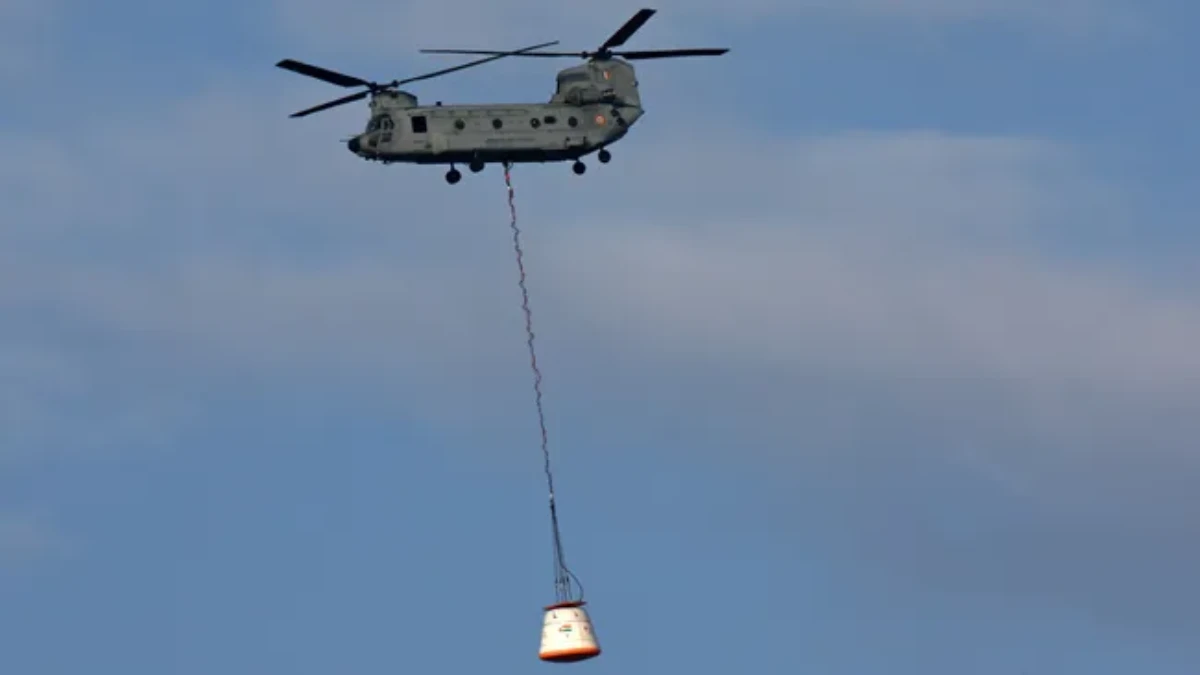| Summary |
|
India has taken a major step toward its first human spaceflight by successfully testing the parachute system for the Gaganyaan crew capsule. On August 24, 2025, engineers at the Satish Dhawan Space Centre dropped a 4.8-tonne mock capsule from an Indian Air Force helicopter flying three kilometers above the ground, reported ISRO.
The test verified that the parachutes could slow the vehicle safely for splashdown in the Bay of Bengal, a key requirement before astronauts fly in 2027.
The sequence began with two small pilot chutes pulling out drogue parachutes to stabilize the descent. Three large main parachutes then deployed, reducing the capsule’s speed to about 7 meters per second. The capsule touched down smoothly in the Bay of Bengal, where the Indian Navy retrieved it. The test also confirmed the system’s ability to handle emergency aborts, such as those during launch failures.
Returning from orbit means decelerating from speeds of 27,000 kilometers per hour. The capsule’s heat shield handles the high temperatures during reentry, but below 10 kilometers parachutes take over.
India’s design uses high-strength nylon canopies that fold into small compartments yet expand to nearly 30 meters across when deployed. The system follows proven approaches used by NASA’s Orion and Russia’s Soyuz but has been adapted for India’s HLVM3 rocket and mission profile.
India plans four uncrewed flights before the first crewed mission. The first, G1, is scheduled for December 2025. It will carry Vyommitra, a half-humanoid robot designed to operate controls, monitor cabin systems, and communicate in Hindi and English. Vyommitra will act as a stand-in for astronauts, testing life support and mission procedures in space without risk to human life.
Four Indian Air Force pilots, Prasanth Balakrishnan Nair, Ajit Krishnan, Angad Pratap, and Shubhanshu Shukla, were chosen for the mission. They have trained in Russia for survival techniques, studied spacecraft systems in India, and practiced operations in the United States.
In June 2025, Shukla gained real orbital experience by flying on Axiom Space’s Ax-4 mission to the International Space Station (ISS). The team will eventually spend three days in a 400-kilometer orbit during Gaganyaan’s first human flight.
The Gaganyaan program, first announced in 2018, was initially planned for 2022 but delayed by the pandemic and design changes. The target is now 2027 for the first crewed launch. According to the Indian Space Research Organisation (ISRO), more than 90 percent of hardware is complete. Funding has been secured for an additional uncrewed test, ensuring systems are fully validated before astronauts board.
Gaganyaan is seen as a foundation for larger projects. ISRO has set goals of developing a national space station by 2040 and preparing for possible crewed missions beyond Earth orbit. The mission builds on India’s achievements, such as the Chandrayaan-3 Moon landing in 2023 and the Aditya-L1 solar observatory launched in 2024. If successful, India will join the United States, Russia, and China as the only nations to send humans into orbit with domestic technology.
More drop tests and abort system drills are scheduled in 2025 and 2026, alongside the uncrewed Gaganyaan launches. These will clear the way for astronauts to fly in 2027. Beyond national prestige, the program aims to develop technologies for long-duration missions and future lunar exploration. For India, the parachute test marks not just the safe return of a capsule but an essential milestone on the road to human spaceflight.

